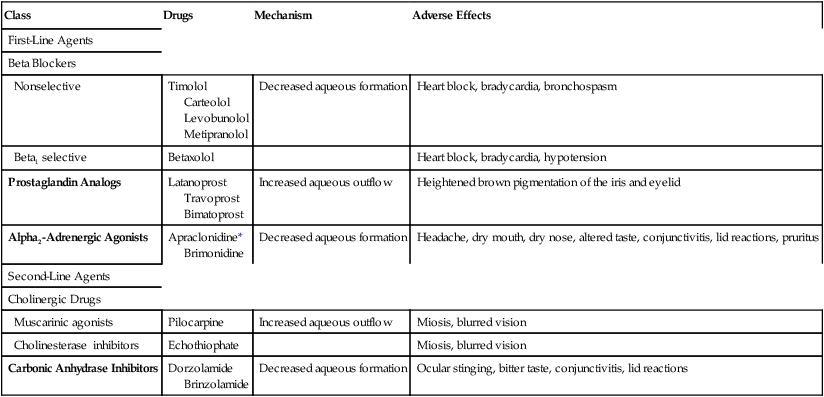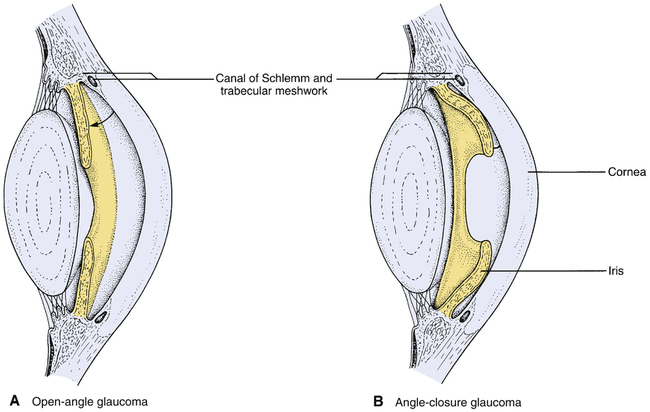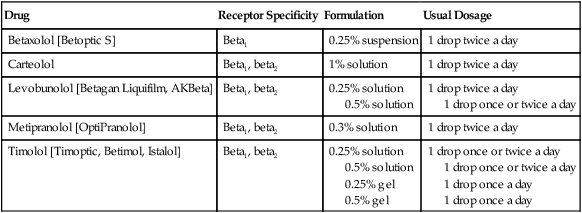CHAPTER 104 Before discussing glaucoma, we need to review the role of aqueous humor in maintaining intraocular pressure (IOP). As indicated in Figure 104–1, aqueous humor is produced by the ciliary body and secreted into the posterior chamber of the eye. From there it circulates around the iris into the anterior chamber, and then exits the anterior chamber via the trabecular meshwork and canal of Schlemm. If outflow from the anterior chamber is impeded, back-pressure will develop, and IOP will rise. Conversely, if production of aqueous humor falls, IOP will decline. The principal method for reducing IOP is chronic therapy with drugs. Drugs lower IOP by either (1) facilitating aqueous humor outflow or (2) reducing aqueous humor production. As indicated in Table 104–1, the first-line drugs for glaucoma belong to three classes: beta-adrenergic blocking agents (beta blockers), alpha2-adrenergic agonists, and prostaglandin analogs. Other options—cholinergic drugs and carbonic anhydrase inhibitors—are considered second-line choices. All of the antiglaucoma drugs are available for topical administration, the preferred route. For more than 25 years, the beta blockers (eg, timolol) have been considered drugs of first choice. However, the alpha2 agonists (eg, brimonidine) and prostaglandin analogs (eg, latanoprost) are just as effective as the beta blockers, and have a more desirable side effect profile. Accordingly, these drugs have joined the beta blockers as first-choice agents. Because drugs in different classes lower IOP by different mechanisms, combined therapy can be more effective than monotherapy. Because all of these drugs are applied topically, systemic effects are relatively uncommon. Nonetheless, serious systemic reactions can occur if sufficient absorption takes place. TABLE 104–1 Topical Drugs for Open-Angle Glaucoma *Apraclonidine is indicated for short-term use only, and hence is not a first-line drug for glaucoma. Angle-closure glaucoma is precipitated by displacement of the iris such that it covers the trabecular meshwork, thereby preventing exit of aqueous humor from the anterior chamber. As a result, IOP increases rapidly and to dangerous levels. This disorder is referred to as angle-closure or narrow-angle glaucoma because the angle between the cornea and the iris is greatly reduced (Fig. 104–2). Angle-closure glaucoma develops suddenly and is extremely painful. In the absence of treatment, irreversible loss of vision occurs in 1 to 2 days. This disorder is much less common than open-angle glaucoma. Five beta blockers—betaxolol, carteolol, levobunolol, metipranolol, and timolol—are approved for use in glaucoma. Dosing is topical. These agents cause minimal disturbance of vision and are considered first-line drugs for glaucoma, although prostaglandin analogs are becoming favored. Formulations and dosages of the beta blockers are summarized in Table 104–2. TABLE 104–2 Beta Blockers Used in Glaucoma The basic pharmacology of the beta blockers is discussed in Chapter 18. Three prostaglandin analogs are approved for topical therapy of glaucoma. These drugs are as effective as the beta blockers and cause fewer side effects. Accordingly, they are considered first-line medications for glaucoma. Formulations and dosages are summarized in Table 104–3. TABLE 104–3 Prostaglandin Analogs Used in Glaucoma Brimonidine [Alphagan] is the first and only topical alpha2-adrenergic agonist approved for long-term reduction of elevated IOP in patients with open-angle glaucoma or ocular hypertension. The recommended dosage is 1 drop 3 times a day. Effects on IOP are similar to those achieved with timolol. The drug lowers IOP by reducing aqueous humor production, and perhaps by increasing outflow. In addition to lowering IOP, brimonidine may delay optic nerve degeneration and may protect retinal neurons from death. This possibility arises from the ability of alpha2 agonists to protect neurons from injury caused by ischemia. The most common adverse effects are dry mouth, ocular hyperemia, local burning and stinging, headache, blurred vision, foreign body sensation, and ocular itching. In contrast to apraclonidine (see below), brimonidine can cross the blood-brain barrier, and hence can cause drowsiness, fatigue, and hypotension. (Recall from Chapter 19 that activation of alpha2 receptors in the brain decreases sympathetic outflow to blood vessels, and thereby lowers blood pressure.) Brimonidine can be absorbed onto soft contact lenses. Accordingly, at least 15 minutes should elapse between drug administration and lens installation.
Drugs for the eye
Drugs for glaucoma

 Anatomy of the normal eye.
Anatomy of the normal eye.
Pathophysiology and treatment overview
Primary open-angle glaucoma
Management.

Class
Drugs
Mechanism
Adverse Effects
First-Line Agents
Beta Blockers
Nonselective
Timolol
Carteolol
Levobunolol
Metipranolol
Decreased aqueous formation
Heart block, bradycardia, bronchospasm
Beta1 selective
Betaxolol
Heart block, bradycardia, hypotension
Prostaglandin Analogs
Latanoprost
Travoprost
Bimatoprost
Increased aqueous outflow
Heightened brown pigmentation of the iris and eyelid
Alpha2-Adrenergic Agonists
Apraclonidine*
Brimonidine
Decreased aqueous formation
Headache, dry mouth, dry nose, altered taste, conjunctivitis, lid reactions, pruritus
Second-Line Agents
Cholinergic Drugs
Muscarinic agonists
Pilocarpine
Increased aqueous outflow
Miosis, blurred vision
Cholinesterase inhibitors
Echothiophate
Miosis, blurred vision
Carbonic Anhydrase Inhibitors
Dorzolamide
Brinzolamide
Decreased aqueous formation
Ocular stinging, bitter taste, conjunctivitis, lid reactions

Angle-closure glaucoma

 Comparative anatomy of the eye in open-angle and angle-closure glaucoma.
Comparative anatomy of the eye in open-angle and angle-closure glaucoma.
A, Note that the angle between the iris and cornea is open in open-angle glaucoma, permitting unimpeded outflow of aqueous humor through the canal of Schlemm and trabecular meshwork. B, Note that the angle between the iris and cornea is constricted in angle-closure glaucoma, thereby blocking outflow of aqueous humor through the canal of Schlemm and trabecular meshwork.
Drugs used to treat glaucoma
Beta-adrenergic blocking agents
Actions and use in glaucoma.

Drug
Receptor Specificity
Formulation
Usual Dosage
Betaxolol [Betoptic S]
Beta1
0.25% suspension
1 drop twice a day
Carteolol
Beta1, beta2
1% solution
1 drop twice a day
Levobunolol [Betagan Liquifilm, AKBeta]
Beta1, beta2
0.25% solution
0.5% solution
1 drop twice a day
1 drop once or twice a day
Metipranolol [OptiPranolol]
Beta1, beta2
0.3% solution
1 drop twice a day
Timolol [Timoptic, Betimol, Istalol]
Beta1, beta2
0.25% solution
0.5% solution
0.25% gel
0.5% gel
1 drop once or twice a day
1 drop once or twice a day
1 drop once a day
1 drop once a day

Prostaglandin analogs

Generic Name
Trade Name
Formulation
Usual Dosage
Latanoprost
Xalatan
0.005% solution
1 drop once daily in the evening
Travoprost
Travatan
0.004% solution
1 drop once daily in the evening
Bimatoprost
Lumigan
0.01% solution
1 drop once daily in the evening
0.03% solution
1 drop once daily in the evening

Alpha2-adrenergic agonists
Brimonidine.

Drugs for the eye
Get Clinical Tree app for offline access


